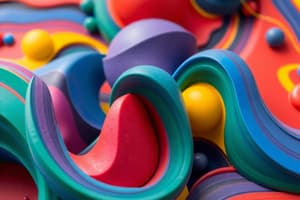Podcast
Questions and Answers
What is the first step in the Generalized Additive Manufacturing Process Chain?
What is the first step in the Generalized Additive Manufacturing Process Chain?
- Conceptualization and CAD (correct)
- Build
- Post-processing of part
- Machine setup
STL stands for Stereolithography.
STL stands for Stereolithography.
True (A)
Name one application area for Additive Manufacturing that does not involve conventional CAD modeling.
Name one application area for Additive Manufacturing that does not involve conventional CAD modeling.
Medical modeling
The process of converting a CAD model to STL involves approximating the surface of the model with a series of __________.
The process of converting a CAD model to STL involves approximating the surface of the model with a series of __________.
Match the different AM systems with their characteristics:
Match the different AM systems with their characteristics:
Which of the following is NOT a step in the AM process chain?
Which of the following is NOT a step in the AM process chain?
Additive Manufacturing is only applicable to metal systems.
Additive Manufacturing is only applicable to metal systems.
What is a key consideration in Design for AM when creating a part?
What is a key consideration in Design for AM when creating a part?
Which process automatically generates supports for molten material systems?
Which process automatically generates supports for molten material systems?
Solid sheets used in lamination methods require supports for their production.
Solid sheets used in lamination methods require supports for their production.
What should be avoided when using material handling systems in additive manufacturing?
What should be avoided when using material handling systems in additive manufacturing?
In additive manufacturing design, features that prevent parts from being easily removed are called __________ features.
In additive manufacturing design, features that prevent parts from being easily removed are called __________ features.
Match the application areas with their respective imaging techniques:
Match the application areas with their respective imaging techniques:
What is one of the key considerations when working with metal systems?
What is one of the key considerations when working with metal systems?
What is a laborious process required after using lamination methods?
What is a laborious process required after using lamination methods?
In the extrusion process, supports must always be generated automatically.
In the extrusion process, supports must always be generated automatically.
What is a possible issue that can arise from poor technique in support removal during additive manufacturing?
What is a possible issue that can arise from poor technique in support removal during additive manufacturing?
Post-processing is exclusively done using manual techniques.
Post-processing is exclusively done using manual techniques.
What is the term used to describe the part that should be separated from the build platform in additive manufacturing?
What is the term used to describe the part that should be separated from the build platform in additive manufacturing?
Some additive manufacturing machines require __________ to prevent parts from collapsing during the building process.
Some additive manufacturing machines require __________ to prevent parts from collapsing during the building process.
Match the following terms with their descriptions:
Match the following terms with their descriptions:
What characteristic do AM parts often exhibit due to the manufacturing process?
What characteristic do AM parts often exhibit due to the manufacturing process?
The properties of parts created through additive manufacturing are often isotropic.
The properties of parts created through additive manufacturing are often isotropic.
Name one advantage of advancements in AM materials and processes.
Name one advantage of advancements in AM materials and processes.
What is one benefit of reverse engineering data using laser scanning technology?
What is one benefit of reverse engineering data using laser scanning technology?
The STL file format is effective for all additive manufacturing technologies.
The STL file format is effective for all additive manufacturing technologies.
What future trend is expected in additive manufacturing regarding materials?
What future trend is expected in additive manufacturing regarding materials?
Additive manufacturing technologies may integrate ______ processing elements as they evolve.
Additive manufacturing technologies may integrate ______ processing elements as they evolve.
Match the following topics with their corresponding descriptions:
Match the following topics with their corresponding descriptions:
What is the nominal layer thickness for most FDM Dimension machines?
What is the nominal layer thickness for most FDM Dimension machines?
Thicker layers in additive manufacturing lead to more precise builds.
Thicker layers in additive manufacturing lead to more precise builds.
What common issue do fine details in a design cause for some AM technologies?
What common issue do fine details in a design cause for some AM technologies?
In powder-based systems, there is no need to use __________.
In powder-based systems, there is no need to use __________.
Match the following AM machine types with their characteristics:
Match the following AM machine types with their characteristics:
What is a requirement for post-processing that involves heat?
What is a requirement for post-processing that involves heat?
With droplet deposition systems, support material cannot be modified as it comes out of the print head.
With droplet deposition systems, support material cannot be modified as it comes out of the print head.
What type of systems primarily use a vat of liquid photopolymer?
What type of systems primarily use a vat of liquid photopolymer?
Which type of radiation is primarily used in photopolymerization processes?
Which type of radiation is primarily used in photopolymerization processes?
Photopolymers were developed in the 1980s.
Photopolymers were developed in the 1980s.
Who conducted experiments with UV curable materials and contributed to sl technology?
Who conducted experiments with UV curable materials and contributed to sl technology?
Photo-curable resins are commonly used in __________ to seal dental surfaces.
Photo-curable resins are commonly used in __________ to seal dental surfaces.
Match the following types of radiation to their usage in curing photopolymers:
Match the following types of radiation to their usage in curing photopolymers:
What is one type of technology discussed in vat photopolymerization processes?
What is one type of technology discussed in vat photopolymerization processes?
Laser-resin interaction is an important factor in photopolymerization process modeling.
Laser-resin interaction is an important factor in photopolymerization process modeling.
Name one component of the photopolymerization materials used in vat photopolymerization.
Name one component of the photopolymerization materials used in vat photopolymerization.
In photopolymerization, the formation of a three-dimensional structure occurs through the process of __________.
In photopolymerization, the formation of a three-dimensional structure occurs through the process of __________.
Match the following scan patterns with their descriptions:
Match the following scan patterns with their descriptions:
Which photopolymerization approach uses a large patterned radiation beam?
Which photopolymerization approach uses a large patterned radiation beam?
In dentistry, UV radiation is predominantly used for photopolymerization.
In dentistry, UV radiation is predominantly used for photopolymerization.
Name one advantage of the two-photon photopolymerization approach.
Name one advantage of the two-photon photopolymerization approach.
The ______ approach involves scanning laser beams in photopolymerization.
The ______ approach involves scanning laser beams in photopolymerization.
Match the photopolymerization processes to their primary configurations:
Match the photopolymerization processes to their primary configurations:
What is the primary role of photoinitiators in photopolymer materials?
What is the primary role of photoinitiators in photopolymer materials?
UV curable photopolymers are mainly used in the food packaging industry.
UV curable photopolymers are mainly used in the food packaging industry.
Name one type of polymerization used in photopolymer chemistry.
Name one type of polymerization used in photopolymer chemistry.
The laser scan vat photopolymerization creates solid parts by selectively solidifying a liquid photopolymer resin using a __________ laser.
The laser scan vat photopolymerization creates solid parts by selectively solidifying a liquid photopolymer resin using a __________ laser.
Match the following types of radiation used for curing photopolymers with their characteristics:
Match the following types of radiation used for curing photopolymers with their characteristics:
Which of the following is NOT a component of the machine subsystem hierarchy in Vector Scan VP machines?
Which of the following is NOT a component of the machine subsystem hierarchy in Vector Scan VP machines?
Interpenetrating polymer networks are formed primarily by the cationic polymerization of acrylates.
Interpenetrating polymer networks are formed primarily by the cationic polymerization of acrylates.
What is the function of the recoater blade in the Vector Scan VP process?
What is the function of the recoater blade in the Vector Scan VP process?
What is the position accuracy in the x-y directions for the atypical point-wise Microsterolithography process?
What is the position accuracy in the x-y directions for the atypical point-wise Microsterolithography process?
Two-photon VAT photopolymerization has no notable speed advantage over laser scan SLA.
Two-photon VAT photopolymerization has no notable speed advantage over laser scan SLA.
What is one main drawback of using photopolymer materials in additive manufacturing?
What is one main drawback of using photopolymer materials in additive manufacturing?
The minimum size of the unit of hardened polymer in atypical Microsterolithography is ______.
The minimum size of the unit of hardened polymer in atypical Microsterolithography is ______.
Match the following characteristics with their respective advantages or drawbacks in Additive Manufacturing:
Match the following characteristics with their respective advantages or drawbacks in Additive Manufacturing:
What is the maximum size of the fabrication structure in the atypical Microsterolithography process?
What is the maximum size of the fabrication structure in the atypical Microsterolithography process?
Surface finishes for slanted angles in SLA can be better than for upfacing surfaces.
Surface finishes for slanted angles in SLA can be better than for upfacing surfaces.
What is the spot size of the UV beam in the specifications for atypical point-wise Microsterolithography?
What is the spot size of the UV beam in the specifications for atypical point-wise Microsterolithography?
Flashcards are hidden until you start studying
Study Notes
Generalized AM Process Chain
- The generalized AM process chain includes eight steps: conceptualization and CAD, conversion to STL, transfer and manipulation of STL file on AM machine, machine setup, build, part removal and cleanup, post-processing of part, and application.
- There are variations in the AM process depending on the machine, material, and desired application.
- Photopolymer-based systems are easy to set up, but have poor mechanical properties compared to other AM materials.
- Powder-based systems do not require supports, while molten material systems do.
- Solid sheet systems require waste material removal, which can be a laborious process.
- Metal systems require careful attention to substrate usage, energy density, weight, accuracy, and speed.
Maintenance of Equipment
- AM machines may use fragile laser or printer technology, requiring careful monitoring and a clean, low-noise environment.
Materials Handling Issues
- Moisture and excess light should be avoided when handling AM materials.
- Material loading is typically done offline using software systems.
- Recycling of unused material from builds is sometimes possible.
Design for AM
- Consider part orientation, support removal, hollowing out, undercuts, interlocking features, part count reduction, and identification markings when designing parts for AM.
Application Areas
- Applications that do not involve conventional CAD modeling include medical modeling (using CT, MRI, and 3D ultrasound), reverse engineering data (using laser scanning technology), and architectural modeling.
- Future developments in AM include thicker layers, processing regions rather than layers, and more complex processes within a single machine.
- Color and multi-material systems will become more common in the future.
- Software is increasingly being optimized for AM processing, including dedicated software for converting designs into printable formats.
- As direct digital manufacturing becomes more common, standardized software processes based around AM will be needed.
Vat Photopolymerization Processes
- Vat Photopolymerization processes are used to cure liquid photopolymers using radiation to create 3D structures.
- Photopolymers materials are primarily used for coating and printing industries and were developed in 1960.
- Radiation sources for curing photopolymers include gamma rays, x-rays, electron beams, UV, and visible light.
- UV and visible light are primarily used for SL systems.
Photopolymerization Materials
- UV curable photopolymers are used as photoresists in the microelectronics industry.
- Photopolymer chemistry includes free radical polymerization (acrylates) and cationic polymerization (epoxies and vinylether).
- Resin formulations use multifunctional monomers (MFM) along with photoinitiator system, monomer formulation, and interpenetrating polymer network formation.
Laser Scan Vat Photopolymerization
- Processes creates solid parts using an UV laser to selectively solidify liquid photopolymer resin.
- Part building involves creating cross-sectional contours or slices, one on top of another.
- Post-curing includes cleaning, post-curing, and finishing (removing support structures, sanding, and filing for desired surface finishes).
Vector Scan VP Machines
- Five main subsystems: recoating system, platform system, vat system, laser and optics systems, and control system.
- Process: after a layer is cured, the platform dips down by a layer thickness, then the recoater blade deposits a new layer of resin and smooths the surface of the vat.
SL Scan Patterns
- Layer-based build phenomena and errors: discretization causes "stair steps".
- WEAVE scan pattern: a back-and-forth zigzag pattern reduces staircase artifacts.
- STAR-WEAVE scan pattern: reduces stair-stepping by alternating the direction of the laser beam.
- ACES scan pattern: a complex pattern featuring serpentine and star-like patterns that reduces contour errors and increases fabrication efficiency.
Vector Scan Micro-Vat Photopolymerization
- Microfabrication applications: using lasers and X-rays as energy sources.
- Atypical point-wise Microsterolithography process: 5-µm spot size of the UV beam, position accuracy of 0.25 µm in x-y directions and 1 µm in z-direction, minimum size of hardened polymer of 5 µm x 5 µm x 3 µm, maximum size of fabrication structure of 10 mm x 10 mm x 10 mm.
Mask Projection VP Technologies and Processes
- Mask Projection VP technology: uses a large radiation beam patterned by a device like a Digital Micromirror Device to irradiate entire layers at one time.
Two-Photon VP
- High resolution point-by-point approach: using the intersection of two scanning laser beams.
Process Benefits and Drawbacks
- Advantages of vat photopolymerization: accuracy (0.002 in/in for SLA-250), surface finish (ranging from submicron Ra for upfacing surfaces to over 100 um Ra for slanted angles), and flexibility.
- Drawbacks of vat photopolymerization: limited chemistries (acrylates and epoxies), low impact strength and durability compared to injection molded thermoplastics, material aging resulting in degraded mechanical properties, limitations for production applications.
Studying That Suits You
Use AI to generate personalized quizzes and flashcards to suit your learning preferences.




